Here is the route of the 100-year-old Tour de Hongrie

Start at Gellért Square, mountaintop finish on Mount Kékes, and finish in front of the Esztergom Basilica – the route of the 46th Hungarian Tour was presented at a gala event at the Budapest Music Centre on the 4th of February.
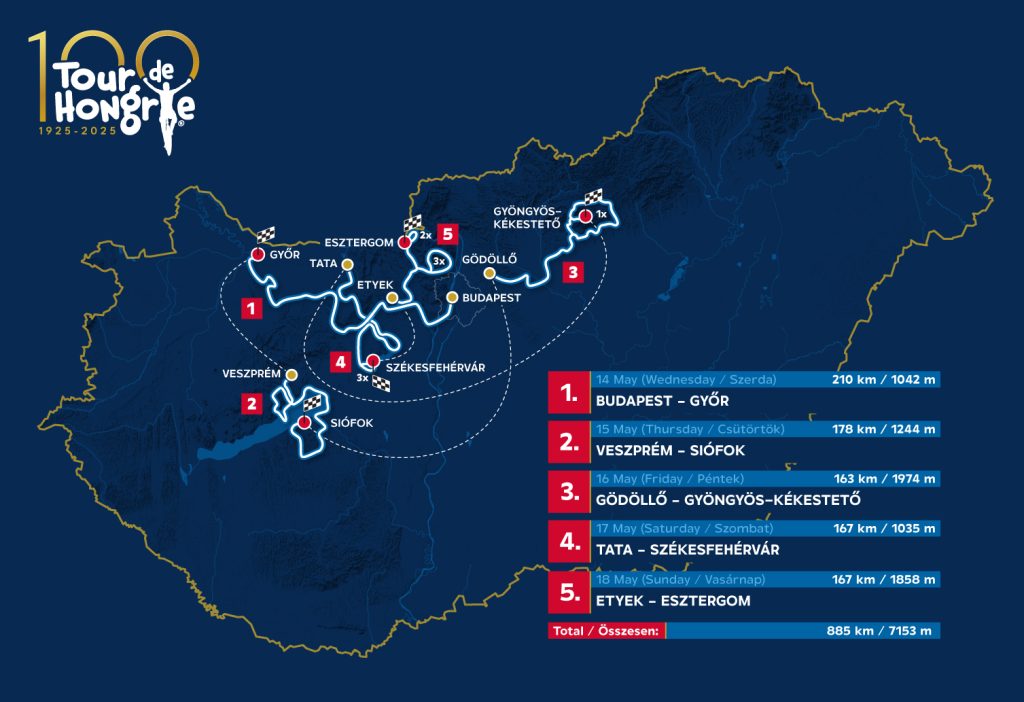
At the event, which was broadcast live on M4 Sport, the channel’s director and host of the evening, Dávid Székely, first greeted the assembled people and then invited to the stage some of the emblematic figures of the competition, which marks its centenary year: 1997 winner Zoltán Bebtó, 2002 champion Zoltán Vanik, and Olympic sixth place finisher József Peterman, who also competed in the 1965 Tour de Hongrie.
At the gala, Gábor Schmidt, Deputy Secretary of State for Sports Administration and Development Affairs, said:
“On the occasion of the anniversary, I would first like to thank the excellent organising team, who do everything year after year to ensure that the Tour de Hongrie develops constantly and gradually becomes more and more prestigious among cycling races – rightfully so. One of our main goals in sports administration is to make regular physical activity an integral part of the lives of as many people as possible. Cycling is our important “ally” in this, as it is one of the most popular community sports, which also helps us discover the values of our country while on the go. I hope that thanks to last year’s fantastic results at the Olympics and this year’s Tour de Hongrie, even more people will join the cycling community in their everyday lives. Those who feel like it, are welcome to join our Active Nation Programme, where members not only receive training tips, but are also offered sports activities at discounted prices and great community sports programs await all interested.”
Gábor Schmidt was followed on stage by Máriusz Révész, State Secretary for an Active Hungary, who explained that “The Tour de Hongrie has become a celebration of cycling in Hungary in recent years. Year after year, superstars ride through the most beautiful landscapes of Hungary, and young Hungarian cyclists also get an opportunity to showcase their talent to the world. Tour de Hongrie makes not only professionals but also amateurs hop on their bikes. It is expected that thousands of people will cycle to the exciting points of the race this year to be part of the experience and cheer on their favourites.”
Dr. Domonkos Schneller, president of the Hungarian Cycling Federation, highlighted the parallel development of Hungarian cycling with the Tour de Hongrie. As he mentioned: “the strength and development of Hungarian cycling is clearly demonstrated by the fact that this is the first time ever that more than 10 Hungarian competitors ride in a ProSeries race for professional teams. In addition to Attila [Valter], Marci [Dina] and Erik [Fetter], a new generation of great young cyclists has emerged, so the 100th Tour de Hongrie may hold surprises from a Hungarian perspective. I’m expecting an exciting and fierce competition!”
Károly Eisenkrammer, main organiser of the Tour de Hongrie, said: “I am very proud that during the centennial history of this race, the longest continuous series of races is associated with me, as this year’s will be the eleventh race of which I am the chief organiser since 2015.” Unfortunately, the “wheel” of Tour de Hongrie has got stuck several times over the past hundred years, but the momentum that drives us now will help us overcome the difficulties, even in headwind. In this work, we’ve found partners such as the National Event Management Agency, the Hungarian Cycling Federation and our partner cities. Planning the route is the most essential part in the organisation of the Tour de Hongrie. It is seemingly simple: one might say it is enough to follow the roads on the map, but in reality, it is a huge amount of work to craft it. A lot of time passes by between the application of potential start and finish cities and the determination of the exact start area or where the finish gate will be located. An important aspect is what TV viewers will see in the background of the race, to show the touristic values of the cities, but above all, to plan the safest possible route for the international field. After all, the cyclists are the heroes of our race, the gladiators who make millions tune in to the Tour de Hongrie while sitting in front of the television, and who get tens of thousands to make a pilgrimage to see the toughest climbs.”
Three-time world champion Peter Sagan, who completed the last ProSeries race of his career at the Tour de Hongrie in 2024, participated in the gala by means of a video message. Hungarian cyclists were represented by Dina Márton who also sent a message to the spectators. Last year, Dina won the white jersey for the best Hungarian cyclist in the race for a record fourth time.
Viktor Filutás from Karcag Cycling Team and Erik Fetter from Team United Shipping took the stage to represent the Hungarian continental teams (the absence of the athletes of Epronex Hungary was justified, they were in a training camp). They were joined by Barnabás Vas, representing MBH Bank Ballan CSB, a team registered in Italy but with an eponymous Hungarian sponsor and five Hungarian racing cyclists.
At the end of the evening, the organisers of the Tour de Hongrie once again dedicated time to social responsibility and presented the Bike School (“Bringasuli”) programme, which contributes to traffic education throughout the country through teacher training, thematic events and educational programmes.
Volunteering was also discussed, as the organisers are also looking for volunteers in Budapest, Győrújbarát, Győr, Veszprém, Tata, Székesfehérvár and Esztergom. Those interested will be able to learn more about the volunteer programme on the communication platforms of Tour de Hongrie in the following days.
The Tour de Hongrie 2025 is jointly organised by the Hungarian Cycling Federation, the Vuelta Sports Office and the National Event Management Agency, with the support of the Active Hungary program and the Ministry of Defence’s State Secretariat for Sports.
Fun facts about the route of the 100-year-old Tour de Hongrie
- This year, the Tour de Hongrie covers a total of 885 km, during which racers must overcome more than 7,000 meters of elevation gain.
- Three stages of the five-day race favour sprinters and one favours mountain specialists – the outcome of the decisive, final stage is unpredictable until the last moment.
- In addition to Budapest, cyclists will race through the counties of Pest, Fejér, Komárom-Esztergom, Győr-Moson-Sopron, Veszprém, Somogy, Jász-Nagykun-Szolnok and Heves. The route passes through a total of 101 settlements.
- Racers can collect points and bonus seconds in a total of 13 intermediate sprints. Time bonuses will be given, with 3, 2 and 1 second awarded to the first, second and third riders.
- 10 categorised climbs stand in the way of cyclists at the 46th Tour de Hongrie. In addition to the first-category Mount Kékes, riders aiming for the red jersey can earn mountain points on four second- and five third-category climbs.
- The 210-kilometre first stage is the longest in the history of Tour de Hongrie since 2008.
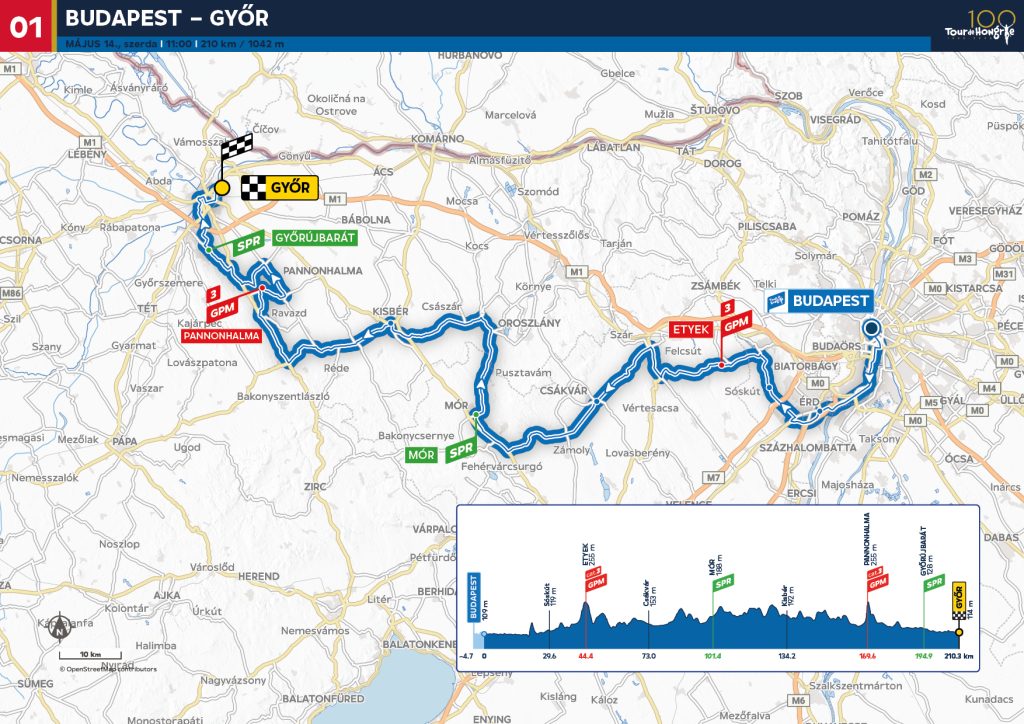
Stage 1 (Budapest – Győr, 210 km)
Start: 14 May 2025 (Wednesday) 11:00, Budapest, Szent Gellért tér (Saint Gellért Square)
Finish: 16:00, Győr, ETO Park
Elevation gain: 1042 m
The 46th Tour de Hongrie starts exactly where the first one did 100 years ago: at Saint Gellért Square. After an official start lap in Budapest, the field leaves the capital and after cycling 210 kilometres, reaches Győr, the start and finish city of the 1925 Tour de Hongrie. The route is made more difficult by two third-category mountain sprints in Etyek and Pannonhalma, while riders can collect seconds and points in Mór and Győrújbarát. At the end of the flat stage, the first yellow jersey of the centennial edition of Tour de Hongrie will probably go to a sprinter.
The Tour will start from Budapest for a record 40th time. Until 1998 every Hungarian Tour started here, with one exception, but the last Grand Start took place in the capital 27 years ago. In 2024, the fourth stage, ending with the victory of Thibau Nys, started from Heroes’ Square. Győr will host the Tour de Hongrie’s field for the 18th time, of which, it will be the host of a final for the 9th time. The “City of Rivers” has played a decisive role in the history of the race, as in addition to hosting the first Tour de Hongrie, when the race was organised again after a 30-year break, the 1993 edition also began with a Budapest – Győr stage. The last time, in 1998, Ukrainian Volodymyr Nazarenko won here.
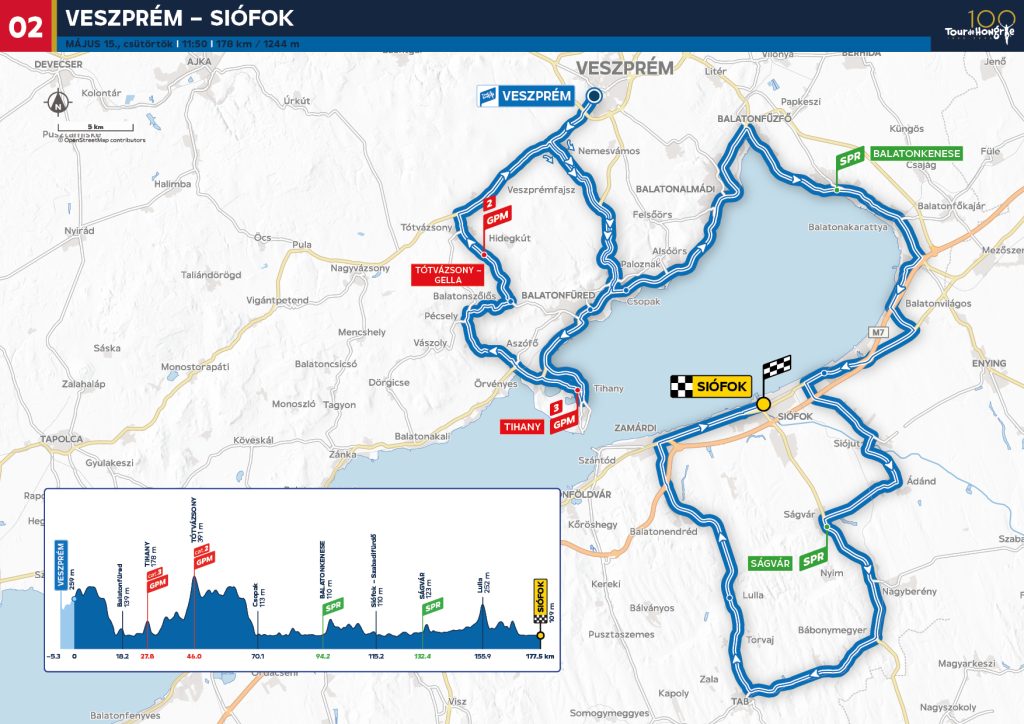
Stage 2 (Veszprém – Siófok, 178 km)
Start: 15 May 2025 (Thursday) 11:50, Veszprém, Óváros tér (Óváros Square)
Finish: 16:00, Siófok, Fő utca
Elevation gain: 1244 m
The Tour de Hongrie will continue with a classic stage at Lake Balaton on the 15th of May. After the start in Veszprém, the field reaches the lake shore at Csopak, then proceeds to the second-category climb of Tótvázsony, passing through Balatonfüred and Tihany, and then doubles back from Nemesvámos to continue its journey along the eastern basin. When reaching Siófok, the caravan turns south to reach the final stretch in Siófok from the direction of Zamárdi, passing through Ságvár and Tab. The wind can make this stage, which includes two categorised climbs and two sprints, truly unpredictable. Under optimal conditions, viewers can once again witness the battle of sprinters.
The “City of Queens”, Veszprém, has hosted eight Tour de Hongrie starts so far, including four Grand Starts in the early 2000s. The last time the field started from Óváros (Old Town) Square was in 2021. Siófok is hosting the Tour for the 19th time, and although several starts have been held here in recent years (2018-19, 2021, 2024), the stage finish took place on the southern shore of Lake Balaton in 2017. Then Slovenian Ziga Jerman won with Scott Sunderland coming in second and Barnabás Peák in third place in the “Summer Capital”.
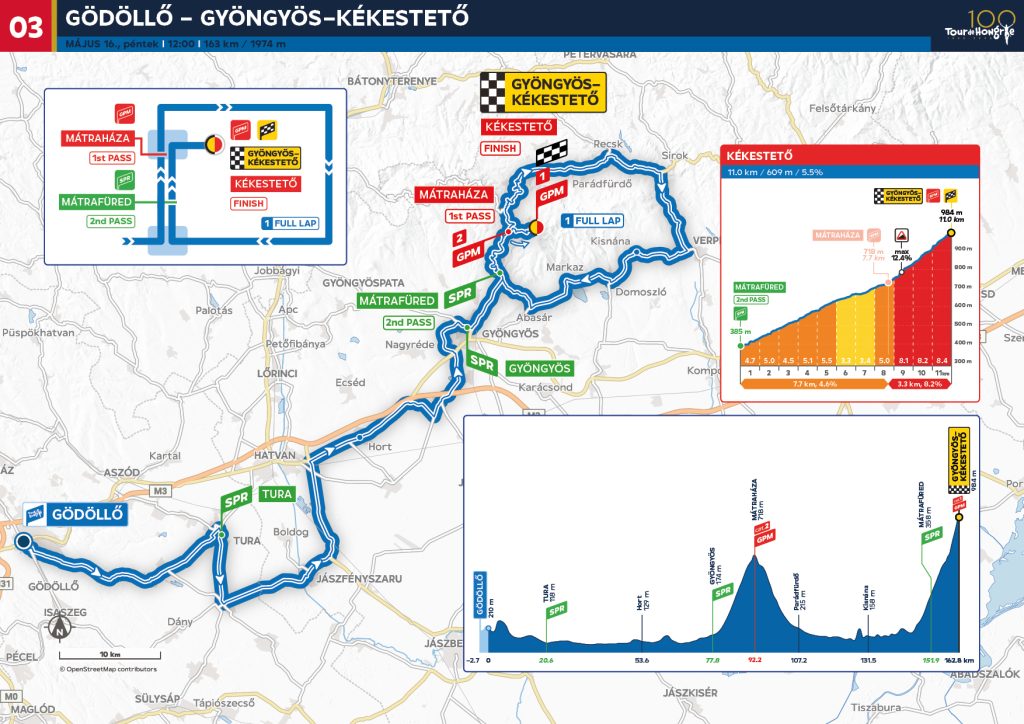
Stage 3 (Gödöllő – Gyöngyös-Kékestető, 163 km)
Start: 16 May 2025 (Friday) 12:00, Royal Castle of Gödöllő
Finish: 16:00, Gyöngyös-Kékestető
Elevation gain: 1974 m
On 16 May, in the royal stage of the race, the Tour de Hongrie field will begin its journey to the mountain peak named Kékestető in front of the Gödöllő Royal Castle. At the end of the stage, which contains three sprints, the usual circuit awaits the competitors in the Mátra Mountain, and then the last three kilometres, with an average gradient of 8.2%, will decide who wins this stage.
The city of Gödöllő is a newcomer to the Tour de Hongrie; this is the first time the race starts from there. The last time the peloton passed through this city of thirty thousand people was in 2016. Kékestető will present a serious challenge to the participants of the Hungarian Tour for the 14th time. In 2001, when this stage was organised for the first time, the Yugoslav Mikos Rnyakovics finished first, while the most recent one was won by the Belgian Thibau Nys in 2024. The most difficult climb in Hungary (11 km; 5.5%) is of outstanding importance from the point of standings: 4 of the last 5 winners of the Kékes stage also triumphed in the general classification.
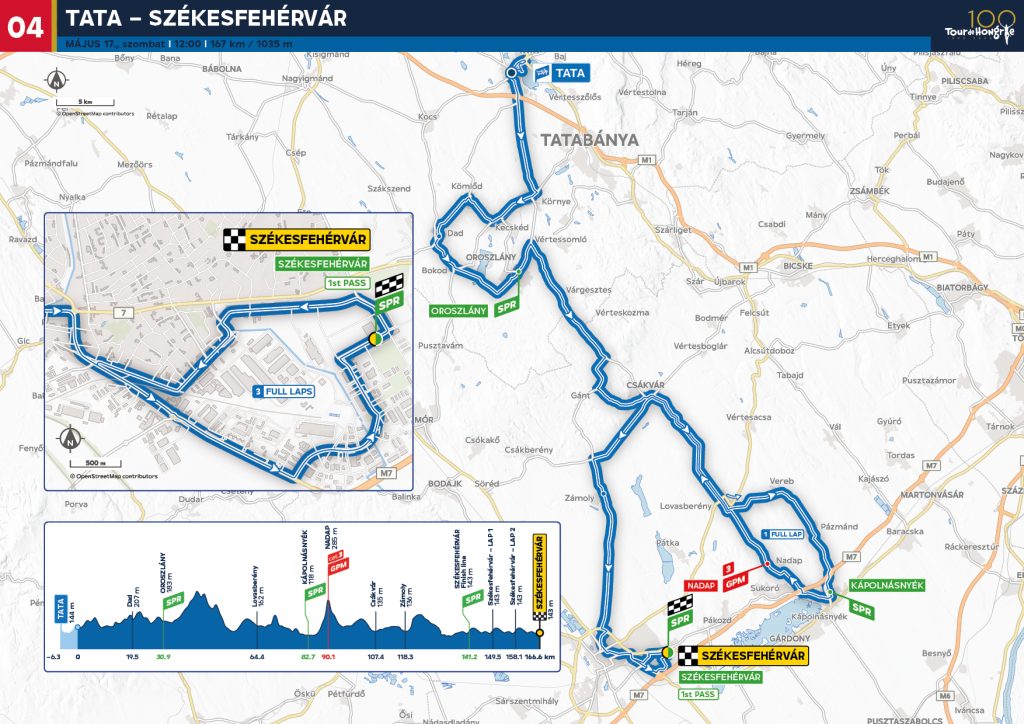
Stage 4 (Tata – Székesfehérvár, 167 km)
Start: 17 May 2025 (Saturday) 12:00, Tata, Kossuth tér (Kossuth Square)
Finish: 16:00, Székesfehérvár, MET Arena
Elevation gain: 1035 m
The “City of Living Waters”, Tata, will host the start of the fourth stage, during which the field will first head towards Lake Bokodi and then Lake Velence. After overcoming a third-category climb in Nadap, the caravan will continue its journey towards Csákvár, then ends in Székesfehérvár, passing through Zámoly. Sprinters will have to complete 3 laps in the vicinity of the MET Arena before they can compete for the stage victory. This stage is made even more interesting by three intermediate sprints.
After a three-year gap, Tata returns to the Tour de Hongrie, this time as a start city. In 2021, German Phil Bauhaus celebrated victory on the streets of the city. Székesfehérvár is hosting the Hungarian Tour for the eighth time, and for the sixth time as a finish city. It’s been 92 years since the Tour was first organised here: In 1933, the Italian Glauco Servadei triumphed in the “City of Kings”. The latest (2022) Székesfehérvár winner is the Dutch sprint star, Olav Kooij, a teammate of Attila Valter.
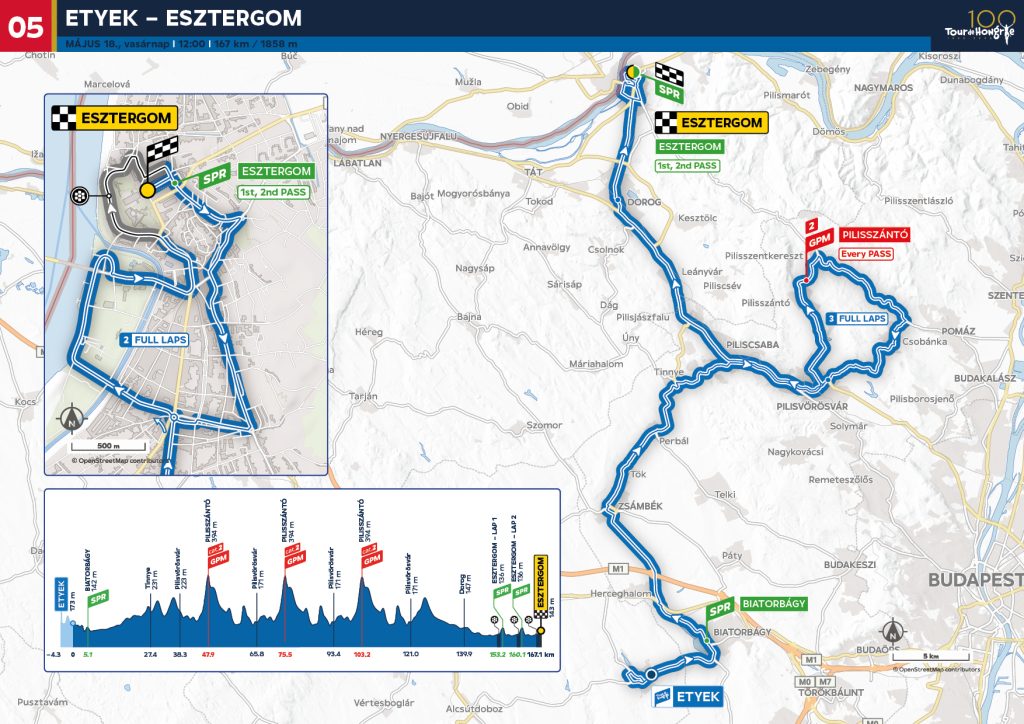
Stage 5 (Etyek – Esztergom, 167 km)
Start: 18 May 2025 (Sunday) 12:00, Etyek, Körpince utca
Finish: 16:00, Esztergom, Basilica
Elevation gain: 1858 m
The decisive, final stage of the 100-year-old Tour de Hongrie is most reminiscent of a Belgian one-day race. Riders start from Etyek and arrive to the slopes of Mount Pilis, where they have to overcome the challenging Pilisszántó slope three times (category 2; 1.8 km; 9% gradient). After the third lap, they turn towards Esztergom, where a seven-kilometre circular track awaits them, featuring a 1.1-kilometre-long section covered with cobblestones with an 8% gradient in some places. After completing 2.5 laps, the century-old Hungarian Tour will end in front of the Basilica. Etyek made its debut as a finish city at the Tour de Hongrie in 2024, and this year it will be home to a stage start for the first time. In 2022 a mountain stage, and in 2023 a sprint was held in the settlement, and last year, the final winner Thibau Nys defeated the reigning champion, Marc Hirschi, in a memorable battle in front of Korda Studios. It is only the fourth time that Esztergom is a featured city on the route and it’s a finish city for the third time. In 2019, Italian Manuel Belletti won here, which contributed to him winning the general classification. In 2020, both the Grand Start of the race and the finish of Stage 1 took place in front of the Basilica – the stage was won by the Basque Jon Aberasturi.















